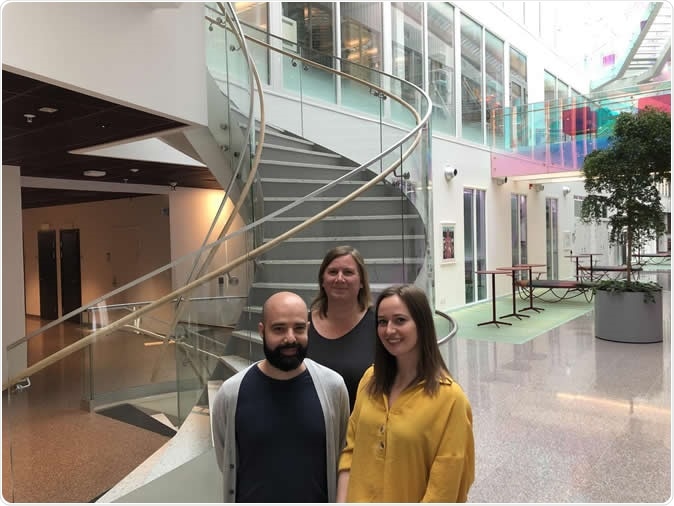
From left: Agustin Sola Carvajal, Maria Eriksson and Gwladys Revechon, researchers at Sweden's Karolinska Institutet and co-authors of the study. Image Credit: Daniel Whisenant
Progeria, also known as Hutchinson-Gilford Progeria Syndrome (HGPS), is an extremely rare genetic disease of childhood marked by dramatic and premature aging. Affecting about one in 18 million children, the disease causes health conditions that are often seen in older adults, including progressive cardiovascular disease, joint stiffness, and hip dislocations.
A team of researchers at Sweden’s Karolinska Institute and IFOM, the FIRC Institute of Molecular Oncology in Italy, has shown how antisense oligonucleotide therapies show promise as a potential treatment for the illness.
Progerin and aging
The study, which was published in the journal Nature Communications, shows that progeria ha genetic causes linked to progerin. The production of broken protein progerin from the Lamin A gene causes the development of the illness. The mutation inhibits cell division, and it was first identified by Maria Eriksson in 2003. She is also a co-author of the present study.Telomeres wear away during cell division and when they reduce sufficiently, the cell stops dividing and dies. When there are dysfunctional telomeres, they activate the production of progerin, which has been tied to age-related cell damage. When telomeres shorten, the cell produces more levels of progerin.
Most patients with progeria die in early adolescence due to complications of cardiovascular disease. At present, there are various treatments aimed to control and slow down the aging process in progeria. However, when it comes to clinical trials, the results are disappointing.
"We have seen positive effects in the treatment of mice, but in humans, the effect has been too small. We, therefore, need to rethink and find new ways to treat the disease," Maria Eriksson, professor at the Department of Biosciences and Nutrition at Karolinska Institutet, said in a statement.
New promise for patients with progeria
The current study shows how antisense oligonucleotides, a treatment utilized to inactivate harmful genes, can help treat progeria. The team used cell samples from progeria-stricken children. They shoed and impaired function in the telomeres at the far end of the chromosomes and the build-up of telomeric non-coding RNA.When the researchers reduced the level of telomeric non-coding RNA after adding antisense oligonucleotides, resulting in normal cell division, the treatment can help prolong the life of children with progeria and improve their quality of life.
The team found a marked increase in both the maximum life expectancy and the average life expectancy, with 44 percent and 24 percent increase, respectively. They suggest that the treatment is effective and promising, providing new hope for children with the illness to live normal and longer lives.
The results may also provide benefits for understanding normal aging and the development of age-related disease.
"More research is needed to assess how the relatively low levels of progerin seen in healthy individuals contribute to aging and age-related disease. It is interesting to note that antisense oligonucleotides are now included as drugs in advanced clinical trials, some of which are already approved by the FDA in the U.S,” Erikson added.
Journal reference:
Aguado, J., Sola-Carvajal, A., Cancila, V. et al. Inhibition of DNA damage response at telomeres improves the detrimental phenotypes of Hutchinson–Gilford Progeria Syndrome. Nat Commun 10, 4990 (2019) doi:10.1038/s41467-019-13018-3, https://www.nature.com/articles/s41467-019-13018-3






No comments
Post a Comment